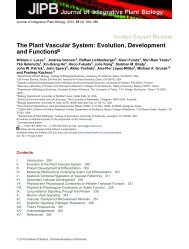Light-Harvesting System of the Red Alga Gracilaria tikvahiae'
Light-Harvesting System of the Red Alga Gracilaria tikvahiae'
Light-Harvesting System of the Red Alga Gracilaria tikvahiae'
Create successful ePaper yourself
Turn your PDF publications into a flip-book with our unique Google optimized e-Paper software.
366 KURSAR ET AL.<br />
MIGRATION -p<br />
FIG. 7. Wild type phycobilisome isolation gradient scanned at 620<br />
and 660 nm. Phycobilisomes were isolated by method II and <strong>the</strong> gradient<br />
was scanned at 620 nm (-) or 660 nm (---).<br />
U.'<br />
Ui<br />
L.'<br />
0<br />
LU<br />
Z<br />
Iz<br />
0<br />
(0<br />
C0<br />
0 0<br />
(0<br />
I--<br />
z<br />
0 C,)<br />
500 600 700<br />
WAVELENGTH (N M)<br />
FIG. 8. Absorbance and fluorescence spectra <strong>of</strong> isolated NMY-1 phycobilisomes.<br />
NMY-I phycobilisomes were isolated by method II on a 10<br />
to 20% gradient after 30 h <strong>of</strong> centrifugation. The absorbance <strong>of</strong> fraction<br />
17 (-) is about 0.35 at 565 nm (in 0.75 M NaK Pi [pH 7.2]). For<br />
fluorescence measurements, samples were diluted into 0.85 M NaK Pi<br />
containing 10% sucrose to give an A <strong>of</strong> 0.04 at 575 nm. The fluorescence<br />
emission spectra (I nm bandpass) <strong>of</strong> fractions 17 (---) and 13 (-)<br />
were determined with excitation at 498 nm (10 nm bandpass). Fractions<br />
13 and 17 correspond to <strong>the</strong> first and second phycobilisome peaks<br />
observed in Figure 6e.<br />
this point was obtained by scanning <strong>the</strong> sucrose gradients at 620<br />
or 660 nm, absorbed principally by PC or APC, respectively,<br />
such as is shown for wild type (Fig. 7). The identical patterns<br />
traced at both wavelengths indicate that <strong>the</strong> PC/APC ratio is<br />
independent <strong>of</strong> phycobilisome size. Inasmuch as for most strains<br />
<strong>the</strong> amount <strong>of</strong> PC and APC per phycobilisome is <strong>the</strong> same<br />
regardless <strong>of</strong> phycobilisome size, <strong>the</strong>n <strong>the</strong> A at 620 nm and hence<br />
<strong>the</strong> gradient scans are a measure <strong>of</strong> phycobilisome number and<br />
not protein mass.<br />
The whole algal pigment contents <strong>of</strong> <strong>the</strong> 'bright green' mutants<br />
vrt2, uai, and NMG-2 are quite similar (13); <strong>the</strong> pigment compositions<br />
<strong>of</strong> <strong>the</strong> isolated phycobilisomes are also quite similar<br />
(Table I, columns c, e, and f). In particular, <strong>the</strong>ir phycobilisome<br />
j<br />
0<br />
Plant Physiol. Vol. 73, 1983<br />
FIG. 9. SDS-PAGE analysis <strong>of</strong> isolated phycobilisomes <strong>of</strong> a number<br />
<strong>of</strong> <strong>Gracilaria</strong> strains. Phycobilisomes were isolated by method II. Gradients<br />
were run until <strong>the</strong> phycobilisomes migrated to <strong>the</strong> bottom third<br />
<strong>of</strong> <strong>the</strong> centrifuge tube and samples were removed from <strong>the</strong> side with a<br />
syringe and dialyzed against (NH4)2SO4 at 50% <strong>of</strong> saturation. The precipitate<br />
was equilibrated with 50 mm NaP1 and electrophoresed as described<br />
in "Materials and Methods." The values on <strong>the</strong> right are mol wt standards<br />
(x 10-3). The phycobilisome samples were as follows: (1) ora, (2) wild<br />
type, (3) vrt, (4) vrI2, (5) uai, (6) ora, (7) wild type, (8) vrt, (9) vrt2, (10)<br />
uai, and (1 1) NMY-1. Lanes I to 5 contain 2 ug APC, lanes 6 to 10<br />
contain 4 Ag APC, and <strong>the</strong> amount loaded in lane 1 I was not determined.<br />
PC/APC ratios are low, 1.5 to 1.7, indicating that <strong>the</strong>y probably<br />
have an incomplete complement <strong>of</strong> PC. The phycobilisomes <strong>of</strong><br />
all three mutants also contain PE; excitation <strong>of</strong> <strong>the</strong> dissociated<br />
phycobilisomes at 498 nm generates a fluorescence emission<br />
spectrum characteristic <strong>of</strong> PE (data not shown [see 13]). The<br />
phycobilisomes <strong>of</strong> vrt2, uai, and NMG-2 have essentially identical<br />
sedimentation patterns (data not shown). At this level <strong>of</strong> analysis,<br />
<strong>the</strong>se three mutants have <strong>the</strong> same phenotype; <strong>the</strong>refore, both<br />
Mendelian and non-Mendelian mutations can result in similar<br />
and marked changes in PE syn<strong>the</strong>sis and incorporation into <strong>the</strong><br />
phycobilisome.<br />
The phycobilisomes <strong>of</strong> NMY-J are exceptional in several regards.<br />
Their composition is 71% PE and 27% APC, with negligible<br />
amounts <strong>of</strong> PC. NMY-1 phycobilisomes migrate as two<br />
bands on sucrose gradients having sedimentation properties similar<br />
to phycobilisomes which contain only 40% PE (for example,<br />
vrt in Figure 60. Even though NMY-J phycobilisomes contain<br />
essentially no PC, <strong>the</strong>y have a fluorescence emission peak at 670<br />
to 674 nm upon excitation at 498 nm (Fig. 8). Apparently PE is<br />
attached directly to APC and transfers excitation energy to APC<br />
efficiently. The phycobilisomes <strong>of</strong> NMY-I are also unstable on a<br />
time scale <strong>of</strong>days, during which wild type phycobilisomes remain<br />
essentially intact. In preliminary experiments on NMY-J cultured<br />
in Halifax, shipped to Chicago and maintainedunder slow<br />
growing conditions, <strong>the</strong> PC/APC ratio <strong>of</strong> <strong>the</strong> isolated phycobilisomes<br />
was about 0.5. These features suggest that NMY-I may be<br />
a leaky mutation whose phenotype depends on growing conditions.<br />
Phycobilisomes <strong>of</strong> <strong>Gracilaria</strong> were shown by SDS-PAGE to<br />
contain a number <strong>of</strong> larger polypeptides, termed linker polypeptides,<br />
in addition to <strong>the</strong> a and ft subunits <strong>of</strong> <strong>the</strong> biliproteins (12-<br />
22 kD). The smallest phycobilisomes, those <strong>of</strong> vrt2 and uai,<br />
which are extremely deficient in PE, contain primarily 29 and<br />
89 kD linker polypeptides (Fig. 9, lanes 4, 5, 9, and 10), while
















